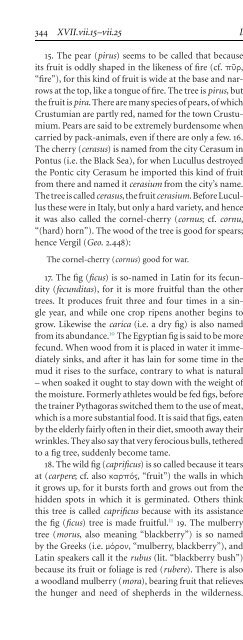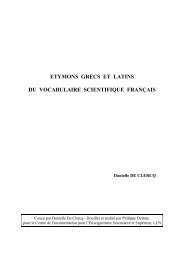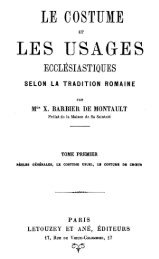The Etymologies of Isidore of Seville - Pot-pourri
The Etymologies of Isidore of Seville - Pot-pourri
The Etymologies of Isidore of Seville - Pot-pourri
You also want an ePaper? Increase the reach of your titles
YUMPU automatically turns print PDFs into web optimized ePapers that Google loves.
344 XVII.vii.15–vii.25 <strong>Isidore</strong> <strong>of</strong> <strong>Seville</strong><br />
15. <strong>The</strong>pear (pirus) seems to be called that because<br />
its fruit is oddly shaped in the likeness <strong>of</strong> fire (cf. ,<br />
“fire”), for this kind <strong>of</strong> fruit is wide at the base and narrows<br />
at the top, like a tongue <strong>of</strong> fire. <strong>The</strong> tree is pirus,but<br />
the fruit is pira.<strong>The</strong>reare many species <strong>of</strong> pears, <strong>of</strong> which<br />
Crustumian are partly red, named for the town Crustumium.<br />
Pears are said to be extremely burdensome when<br />
carried by pack-animals, even if there are only a few. 16.<br />
<strong>The</strong> cherry (cerasus)isnamedfromthe city Cerasum in<br />
Pontus (i.e. the Black Sea), for when Lucullus destroyed<br />
the Pontic city Cerasum he imported this kind <strong>of</strong> fruit<br />
from there and named it cerasium from the city’s name.<br />
<strong>The</strong> tree is called cerasus,thefruit cerasium.BeforeLucullus<br />
these were in Italy, but only a hard variety, and hence<br />
it was also called the cornel-cherry (cornus; cf. cornu,<br />
“(hard) horn”). <strong>The</strong> wood <strong>of</strong> the tree is good for spears;<br />
hence Vergil (Geo. 2.448):<br />
<strong>The</strong> cornel-cherry (cornus) good for war.<br />
17. <strong>The</strong>fig(ficus) isso-named in Latin for its fecundity<br />
(fecunditas), for it is more fruitful than the other<br />
trees. It produces fruit three and four times in a single<br />
year, and while one crop ripens another begins to<br />
grow. Likewise the carica (i.e. a dry fig) is also named<br />
from its abundance. 10 <strong>The</strong> Egyptianfigissaidtobemore<br />
fecund. When wood from it is placed in water it immediately<br />
sinks, and after it has lain for some time in the<br />
mud it rises to the surface, contrary to what is natural<br />
–whensoakeditought to stay down with the weight <strong>of</strong><br />
the moisture. Formerly athletes would be fed figs, before<br />
the trainer Pythagoras switched them to the use <strong>of</strong> meat,<br />
which is a more substantial food. It is said that figs, eaten<br />
by the elderly fairly <strong>of</strong>ten in their diet, smooth away their<br />
wrinkles. <strong>The</strong>y also say that very ferocious bulls, tethered<br />
to afigtree, suddenly become tame.<br />
18.<strong>The</strong>wild fig (caprificus)issocalled because it tears<br />
at (carpere; cf. also , “fruit”) the walls in which<br />
it grows up, for it bursts forth and grows out from the<br />
hidden spots in which it is germinated. Others think<br />
this tree is called caprificus because with its assistance<br />
the fig (ficus) tree ismade fruitful. 11 19. <strong>The</strong>mulberry<br />
tree (morus, also meaning “blackberry”) is so named<br />
by the Greeks (i.e. , “mulberry, blackberry”), and<br />
Latin speakers call it the rubus (lit. “blackberry bush”)<br />
because its fruit or foliage is red (rubere). <strong>The</strong>re is also<br />
awoodlandmulberry (mora), bearing fruit that relieves<br />
the hunger and need <strong>of</strong> shepherds in the wilderness.<br />
It is said that its leaves, when thrown onto a serpent,<br />
destroy it.<br />
20. <strong>The</strong>‘sycamore fig’ (sycomorus), along with the<br />
mulberry (morus), have Greek names (i.e. ,<br />
). It is called sycomorus (cf. , “fig”) because<br />
its leaves are like the morus. Latin speakers call this<br />
the ‘l<strong>of</strong>ty’ (celsus) figbecause <strong>of</strong> its height, for it is<br />
not short like the mulberry. 21. <strong>The</strong>walnut (nux) is<br />
so called because its shade or drippings from its leaves<br />
harm (nocere)neighboringtrees. Latin speakers call it by<br />
another name, iuglans, asifitwere‘Jupiter’snut’(Iovis<br />
glans), for this tree was consecrated to Jupiter. Its fruit<br />
has so much virtue that, when it is mingled with suspicious<br />
food containing herbs or mushrooms, it drives<br />
out, seizes, and destroys whatever is poisonous in it.<br />
22. All fruits covered with a rather hard shell are generically<br />
called ‘nuts’ (nux), as pine nuts (pinea), filberts,<br />
acorns (glans), chestnuts, almonds. <strong>The</strong> kernel (nucleus)<br />
is also named from nux,because it is covered with a hard<br />
shell. On the other hand every s<strong>of</strong>t fruit is called malum,<br />
but this term is modified by the names <strong>of</strong> the regions<br />
in which they originated, as Persian, Punic, Matian,<br />
Cydonian, and so forth.<br />
23. Almond (amygdala) is a Greek name (i.e.<br />
), which in Latin is called ‘long nut.’ Others<br />
call it nucicla,asifitwere “the little nut.” Concerning it,<br />
Vergil (Geo. 1.187):<br />
When many a nut tree (nux) inthe woods clothes itself<br />
in flowers.<br />
For among all the trees it first clothes itself in flower, and<br />
bears fruit before the other trees. 24. Filberts(abellana)<br />
are given their name from Abella, a town in Campania,<br />
where they are abundant. <strong>The</strong>se are called Pontic<br />
nuts by the Greeks, because they are abundant around<br />
the Pontic (i.e. Black) Sea. 25. Latin speakers name the<br />
chestnut (castanea) fromaGreekterm, for the Greeks<br />
call it ,because its paired fruits are hidden in a<br />
small sack like testicles, and when they are ejected from<br />
it, it is as if they were castrated (castrare). As soon as<br />
this tree is cut down, it commonly sprouts again like a<br />
forest.<br />
10 That is, the Carica fig is abundant in the province <strong>of</strong> Caria in<br />
Asia Minor, whence its name.<br />
11 Pliny explains that “caprification” is the attachment to cultivated<br />
fig trees <strong>of</strong> wild figs, from which gall insects emerge and pollinate<br />
the flowers.

















